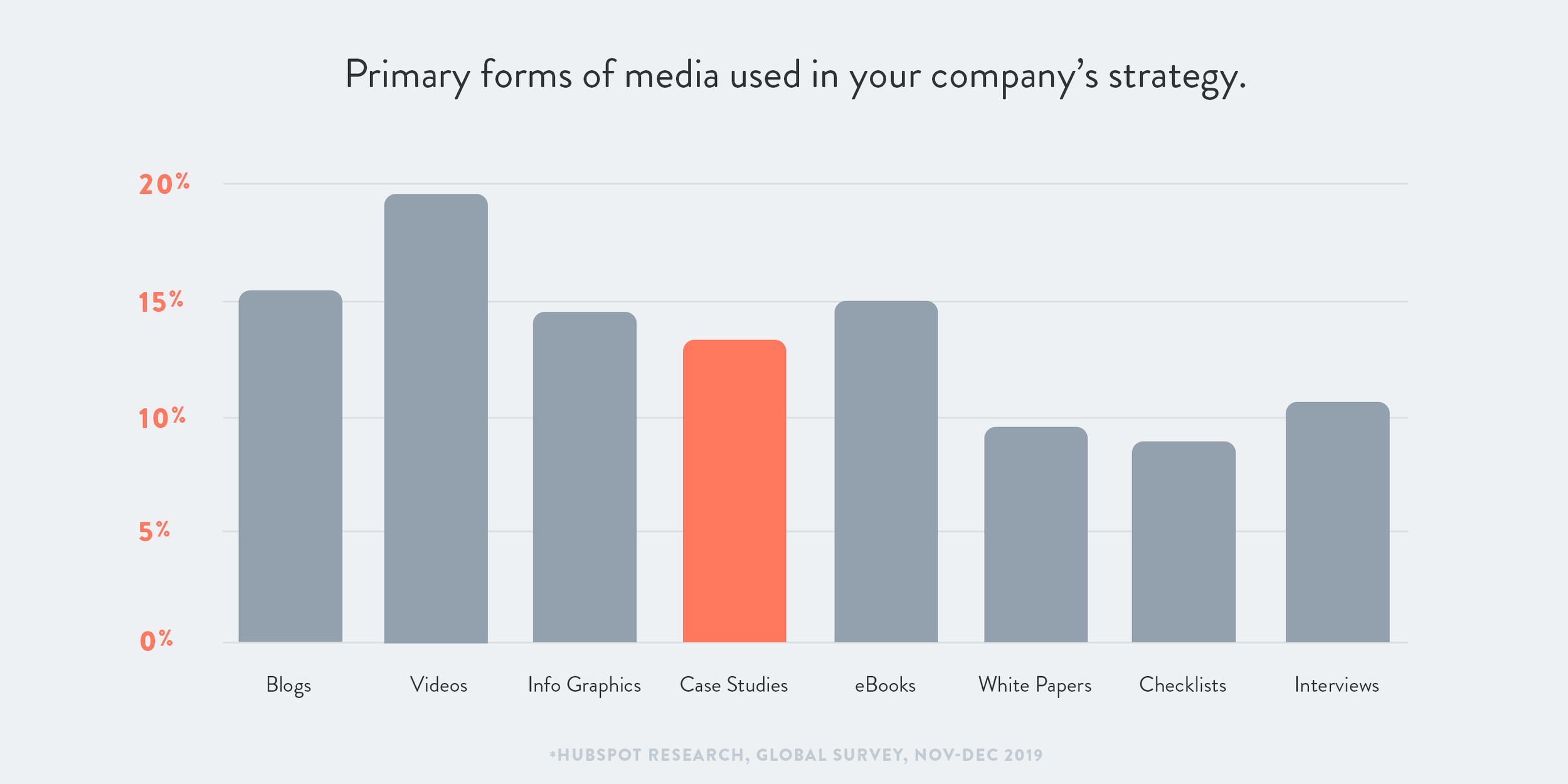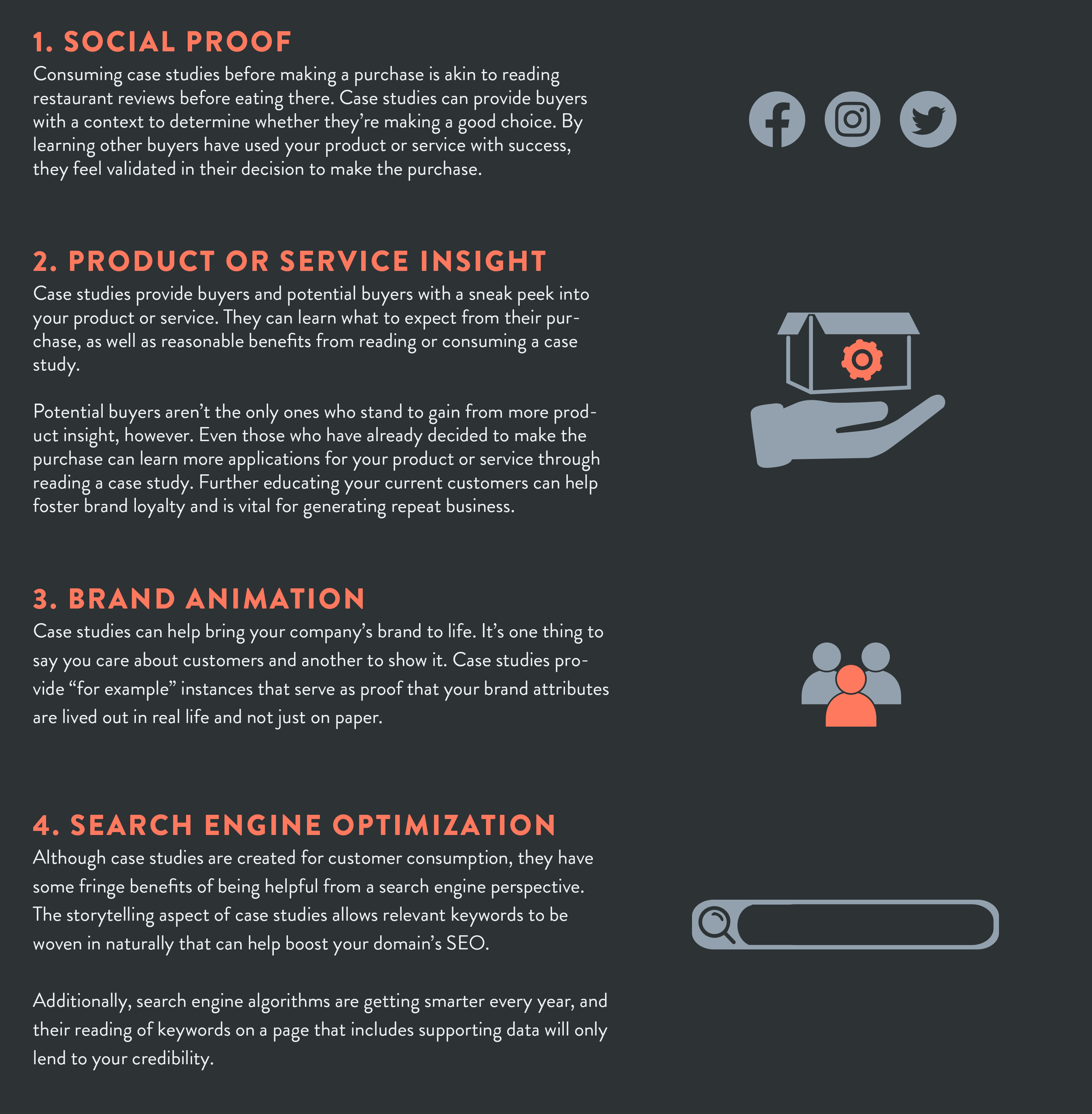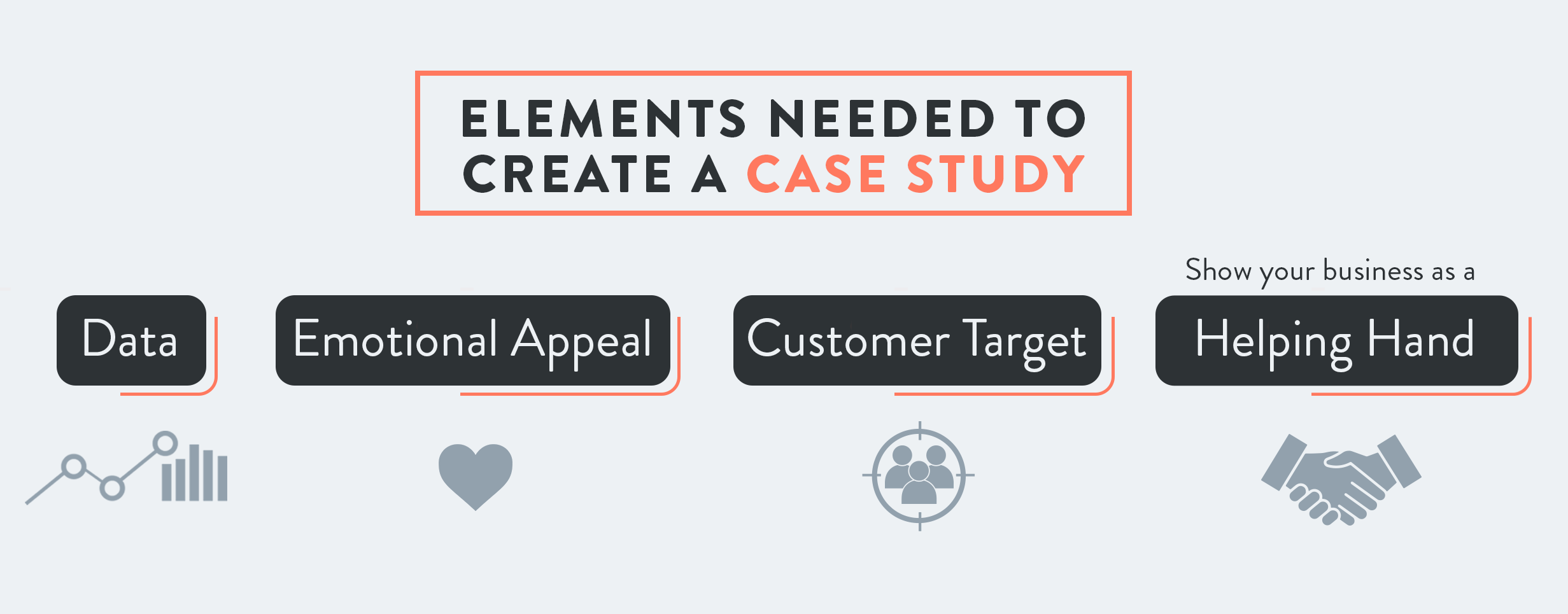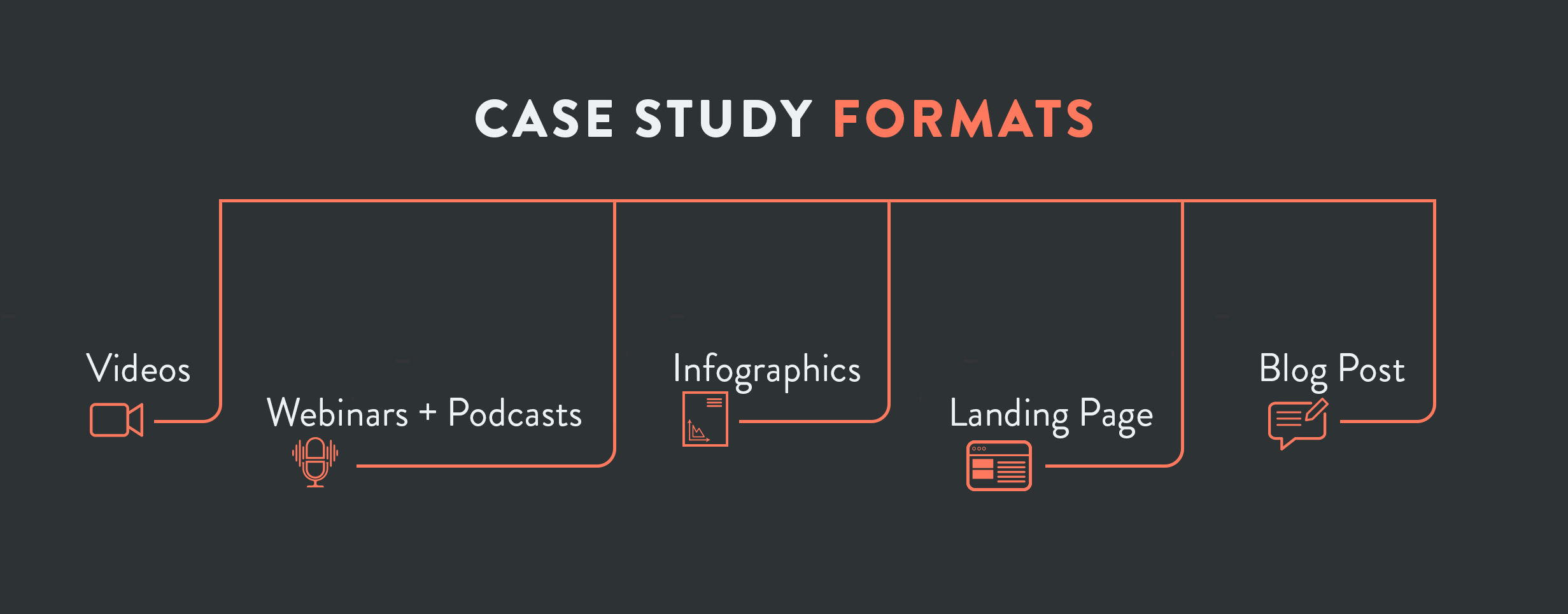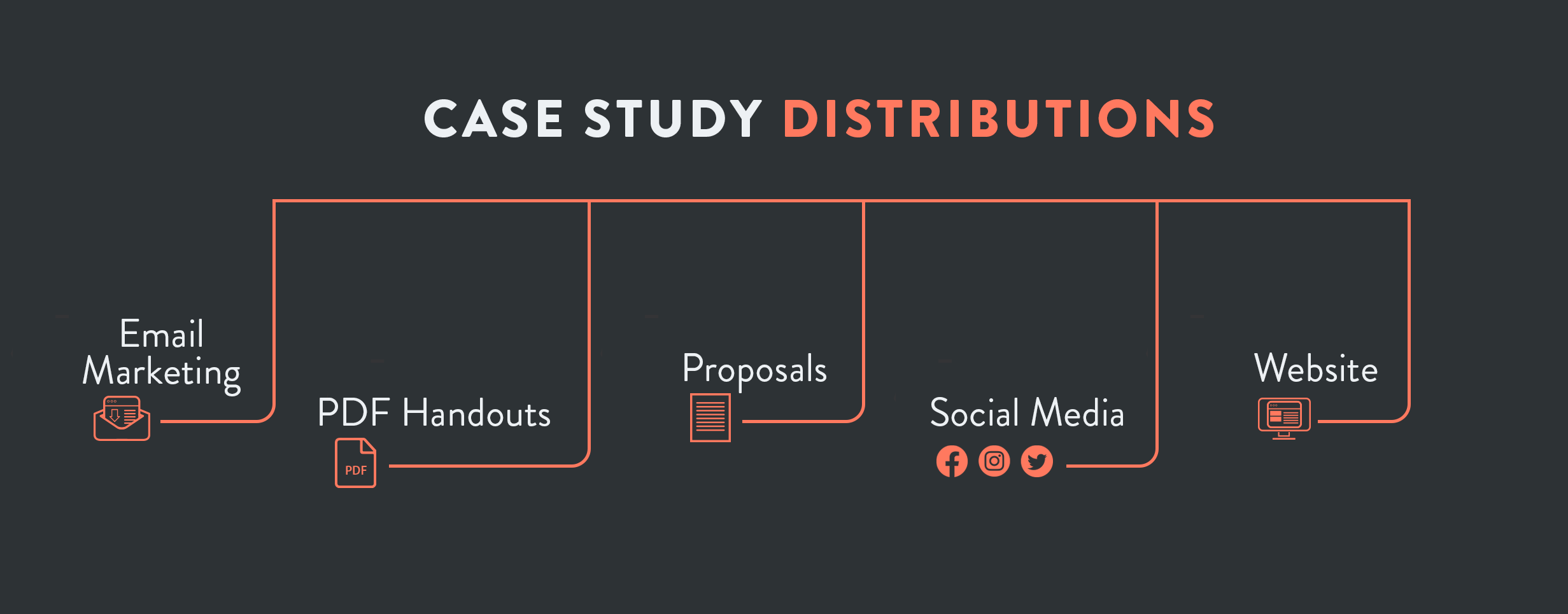HOW TO CREATE EFFECTIVE CASE STUDIES
The goal of marketing is sharing your product or service with customers, and case studies provide the perfect way to accomplish this. This in-depth analysis helps tell a story about a customer and your company in a method that sounds like a story.
The case study is a valuable content marketing asset that helps capture wandering minds, tell a story about your company and provide significant benefits.
WHAT EXACTLY CONSTITUTES A CASE STUDY?
A case study is an expansion of a testimonial but with more evidence. By analyzing a particular instance, or “case,” to show results, case studies expand on a problem and explain how your business provided a solution.
Case studies can take several different forms, which we’ll discuss later in this post.
BENEFITS OF CASE STUDIES
According to HubSpot’s State of Marketing Report 2020, 13% of marketers name case studies as one of the primary forms of media used within their content strategy, making them the fifth most popular type of content. Here’s what makes them so great.
HOW TO CREATE A GOOD CASE STUDY
Data and Emotion Work in Conjunction
There are two main elements every case study should include: data and emotion. You might think these are two conflicting goals, but the best case studies have them working in conjunction.
Start with the data
By providing quantifiable data, case studies can make practical appeals to those who are relying on numbers to make decisions. If results can be measured, include them. Make sure to include any numbers possible to prove the validity of the study.
Avoid broad, generalized statements and instead use specific numbers. Don’t, for example, say “we doubled revenue” without including the original revenue numbers, or customers will wonder if revenue started at $10, 10,000, or $100,000.
Charts, graphs, and other analytical data can also be a helpful asset to help provide proof. Remember to highlight the most important pieces of data and provide context to why they matter so those who aren’t as familiar with these instances will understand the point you’re making.
Include emotional appeal
Humans are emotional creatures as well as logical, so case studies should include an emotional appeal as well, best portrayed through storytelling.
We’ll address the different types of case study dissemination, but no matter what forms your case studies take, they all need to tell a good story. Mapping out that story should be the first step in your case study creation.
Every good story has a clear beginning, middle, and end. Case studies should also include a narrative that people can easily follow while also learning about the value your business provides.
TARGETING YOUR IDEAL CUSTOMER
Every case study should be written so that your ideal customer can relate to it. If you don’t know who your ideal customer is, back up and take a second to determine that. Keep in mind that you’ll probably have different types of ideal customers, depending on your target audiences.
If your ideal customer is someone in the manufacturing industry, for example, your case study should address needs that manufacturing clients would have, such as supply chain and automation concerns. If your ideal customer works in education, your case studies could focus on university sales. And so on.
Knowing who you’re creating this case study for and having that in mind can help you make informed decisions about what type of language to use, what data to include, what format to follow, and even what channels should be used for distribution.
Your goal with the case study is to show your prospective customers you are:
Comfortable in their industry
Understand their needs and speak their language
Know how to provide the results they need
FRAMING YOUR BUSINESS AS A HELPFUL, SUPPORTING CHARACTER
Although the customer should play the main role in the case study, your company or product should play the role of a supporting character. If your company is the main character, the case study is less believable and becomes more difficult for customers to identify with.
Remember that people buy products or services to solve specific problems they have. Because of this, every case study’s story should position your company as a helping hand that helped the real hero — the customer — overcome their challenge.
TYPES OF CASE STUDIES
As with any valuable piece of content, case studies do not have to take just one form. Once you have a good story in place, you can create the type — or types — of content that will best suit your target audiences.
One way to get the most mileage out of your efforts is to create a written case study with all the information you need and then repurpose that content into different forms. Here are some ideas for repurposing a written case study that can also double as the primary form:
Videos
Case study videos can take many different forms. Perhaps this could be in an interview format with the customer or simply a text-based video that highlights some of the main points of the case study. Whatever the format, video is a highly effective communication tool that can be a huge asset to communicating your case study message.
Infographics
Infographics have long been a content favorite for communicating a large amount of data. If you have a case study that’s particularly data heavy, repurposing some of that content into an infographic form could be effective.
Webinars or podcasts
Depending on the amount of information you receive from your case study, it could help inform a webinar or podcast episode. Whether the case study data is just supporting a broader message or you’re able to include a customer interview in audible form, case studies can help support other marketing communications tactics.
Landing page
Using your case studies to create or support website pages is another way to attract some digital attention. Perhaps your case study data can be used to encourage potential customers to fill out a form, capturing leads. Or maybe it can just help support your product pages.
Blog post
The storytelling capabilities within case studies often lend themselves to strong blog posts as well. As with many of these other types, the case study could be just a part of a broader point made within the post but can provide a substantial bolster for your claims.
METHODS OF CASE STUDY DISTRIBUTION
You can’t talk about the type of content form your case study should take without also considering the distribution method. In fact, the distribution method might even direct the type of content necessary. A social distribution, for example, should probably include a video type for the best engagement levels.
Here are some channels for case study distribution:
Email marketing
Can be used to reopen a conversation with potential or previous customers
PDF handouts
Great for in-person sales team meetings or trade show distribution
Proposals
Provide proof your company is effective
Social media
Can be impactful, especially if your customers share as well
Website
Great for blogs, landing pages, case study resource pages and product/service pages
Housing Matters
Above all, the most important aspect to consider for case study housing is that they should be easy to find. A potential customer shouldn’t just “stumble” across these buried deep on a resources page. As some of your most valuable assets, case studies should be some of your most featured content.
Depending on how many case studies you have, you should also provide some method of sorting and organizing them. Consider having the ability to sort by either product/service or application for easy finding.
CREATING YOUR OWN CASE STUDY
Your company is unique, so it’s important to create a case study that best reflects your target audience, your brand attributes, your product or service, and your customer’s story. That means no two case studies will be the same, another helpful enhancement that marketing case studies can provide.
Check out our case study page for guidance and inspiration for your next case study.

